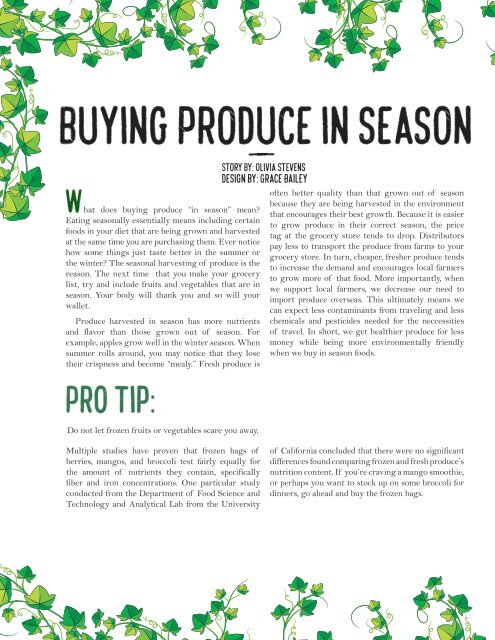Create successful ePaper yourself
Turn your PDF publications into a flip-book with our unique Google optimized e-Paper software.
Buying produce in season<br />
Organic Foods<br />
|<br />
Just a Fad?<br />
What does buying produce “in season” mean?<br />
Eating seasonally essentially means including certain<br />
foods in your diet that are being grown and harvested<br />
at the same time you are purchasing them. Ever notice<br />
how some things just taste better in the summer or<br />
the winter? The seasonal harvesting of produce is the<br />
reason. The next time that you make your grocery<br />
list, try and include fruits and vegetables that are in<br />
season. Your body will thank you and so will your<br />
wallet.<br />
Produce harvested in season has more nutrients<br />
and flavor than those grown out of season. For<br />
example, apples grow well in the winter season. When<br />
summer rolls around, you may notice that they lose<br />
their crispness and become “mealy.” Fresh produce is<br />
Pro tip:<br />
Do not let frozen fruits or vegetables scare you away.<br />
|<br />
Story By: Olivia Stevens<br />
Design by: Grace Bailey<br />
often better quality than that grown out of season<br />
because they are being harvested in the environment<br />
that encourages their best growth. Because it is easier<br />
to grow produce in their correct season, the price<br />
tag at the grocery store tends to drop. Distributors<br />
pay less to transport the produce from farms to your<br />
grocery store. In turn, cheaper, fresher produce tends<br />
to increase the demand and encourages local farmers<br />
to grow more of that food. More importantly, when<br />
we support local farmers, we decrease our need to<br />
import produce overseas. This ultimately means we<br />
can expect less contaminants from traveling and less<br />
chemicals and pesticides needed for the neccessities<br />
of travel. In short, we get healthier produce for less<br />
money while being more environmentally friendly<br />
when we buy in season foods.<br />
Organic foods have been on the rise; we can barely scroll<br />
through Instagram without seeing some type of healthy,<br />
organic recipe or individual praising their “so natural”<br />
lifestyle and diet. What can we make of this trend of eating<br />
green? Are organic foods really healthier for us, or is it all a<br />
myth? It is true that the USDA stated that organic produce<br />
proves to come at a heftier cost. How do we decide what is<br />
actually better for us, and what justifies breaking the bank<br />
for our health?<br />
First, it is important to understand what “organic” means.<br />
When we talk about organic foods, we are referring to the<br />
processes in which that food has been grown and harvested.<br />
You can check if a food is organic or not by looking for<br />
the USDA Organic seal. That produce marked with the seal<br />
Food for Thought<br />
Buying completely organic is simply not an option for some.<br />
There is controversy on what to buy and what not to buy<br />
organic, but there are some foods that the majority agree<br />
it is best to buy organic because of the pesticides used on<br />
means that they are grown without pesticides, unnatural<br />
fertilizers, genetically modified organisms (GMOs), and<br />
radiation. Animal products that are labeled organic are not<br />
given additional hormones or antibiotics. There is a catch,<br />
however. Before busting out your wallet, it is important to<br />
educate yourself on different labels that you will find at your<br />
grocery store. The label “100% Organic” means exactly that,<br />
all ingredients will be certified organic. The label “Organic”<br />
means that at the very least, 95% of ingredients are certified.<br />
“Made with Organic Ingredients” however means that 70%<br />
of ingredients must be certified organic. Do not be confused<br />
with labels saying “farm-raised” or “natural” because these<br />
have not been government regulated.<br />
the crops. This list include, but is not limited to: peanut<br />
butter, popcorn, strawberries, spinach, apples, grapes, beef,<br />
tomatoes, cucumbers and lettuce.<br />
Multiple studies have proven that frozen bags of<br />
berries, mangos, and broccoli test fairly equally for<br />
the amount of nutrients they contain, specifically<br />
fiber and iron concentrations. One particular study<br />
conducted from the Department of Food Science and<br />
Technology and Analytical Lab from the University<br />
of California concluded that there were no significant<br />
differences found comparing frozen and fresh produce’s<br />
nutrition content. If you’re craving a mango smoothie,<br />
or perhaps you want to stock up on some broccoli for<br />
dinners, go ahead and buy the frozen bags.<br />
15














